The GeForce GTX 660 Ti Review, Feat. EVGA, Zotac, and Gigabyte
by Ryan Smith on August 16, 2012 9:00 AM ESTOC: Power, Temperature, & Noise
Our final task is our look at the overclocking capabilities of our GTX 660 Ti cards. Based on what we’ve seen thus far with GTX 660 Ti, these factory overclocked parts are undoubtedly eating into overclocking headroom, so we’ll have to see just what we can get out of them. The very similar GTX 670 topped out at around 1260MHz for the max boost clock, and between 6.6GHz and 6.9GHz for the memory clock.
| GeForce 660 Ti Overclocking | |||||
| EVGA GTX 660 Ti SC | Zotac GTX 660 Ti AMP | Gigabyte GTX 660 Ti OC | |||
| Shipping Core Clock | 980MHz | 1033MHz | 1033MHz | ||
| Shipping Max Boost Clock | 1150MHz | 1175MHz | 1228MHz | ||
| Shipping Memory Clock | 6GHz | 6.6GHz | 6GHz | ||
| Shipping Max Boost Voltage | 1.175v | 1.175v | 1.175v | ||
| Overclock Core Clock | 1030MHz | 1033MHz | 1083MHz | ||
| Overclock Max Boost Clock | 1200MHz | 1175MHz | 1278MHz | ||
| Overclock Memory Clock | 6.5GHz | 6.8GHz | 6.6GHz | ||
| Overclock Max Boost Voltage | 1.175v | 1.175v | 1.175v | ||
As we suspected, starting with factory overclocked cards isn’t helping here. Our Zotac card wouldn’t accept any kind of meaningful GPU core overclock, so it shipped practically as fast as it could go. We were able to squeeze out another 200MHz on the memory clock though.
Meanwhile our EVGA and Gigabyte cards fared slightly better. We could push another 50MHz out of their GPU clocks, bringing us to a max boost clock of 1200MHz on the EVGA card and 1278MHz on the Gigabyte card. Memory overclocking was similarly consistent; we were able to hit 6.5GHz on the EVGA card and 6.6GHz on the Gigabyte card.
Altogether these are sub-5% GPU overclocks, and at best 10% memory overclocks, which all things considered are fairly low overclocks. The good news is that reference-clocked cards should fare better since their headroom has not already been consumed by factory overclocking, but binning also means the best cards are going to be going out as factory overclocked models.
Moving on to our performance charts, we’re going to once again start with power, temperature, and noise, before moving on to gaming performance.

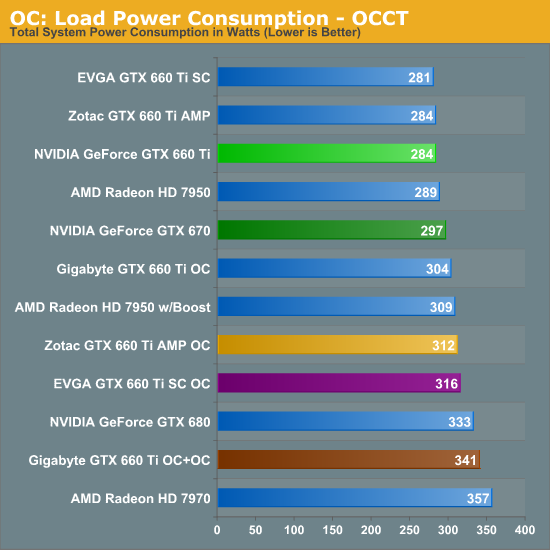
Unsurprisingly, given the small power target difference between the GTX 670 and the GTX 660 Ti, any kind of overclocking that involves raising the power target quickly pushes power consumption past the GTX 670’s power consumption. How much depends on the test and the card, with the higher power target Gigabyte card starting with a particular disadvantage here as its power consumption ends up rivaling that of the GTX 680.
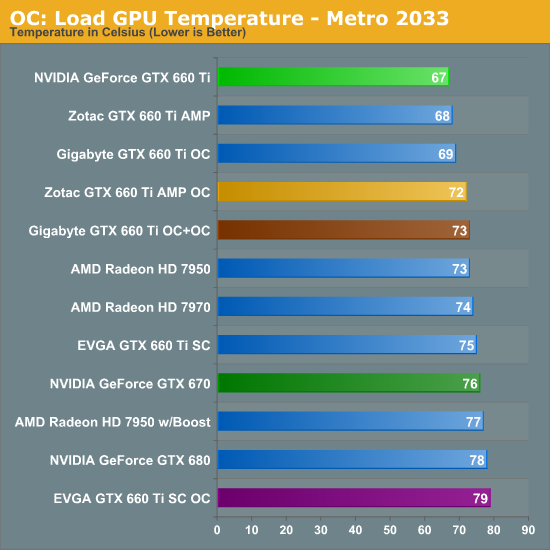
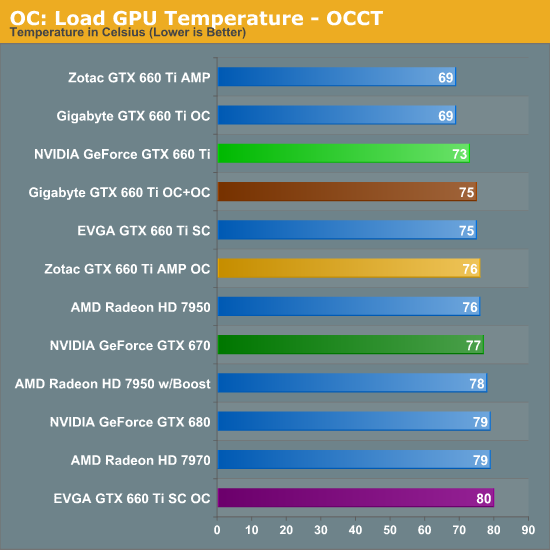
We also see the usual increase in load temperatures due to the increased power consumption. The Zotac and Gigabyte cards fare well enough due to their open air coolers, but the blower-type EVGA card is about as high as we want to go at 80C under OCCT.
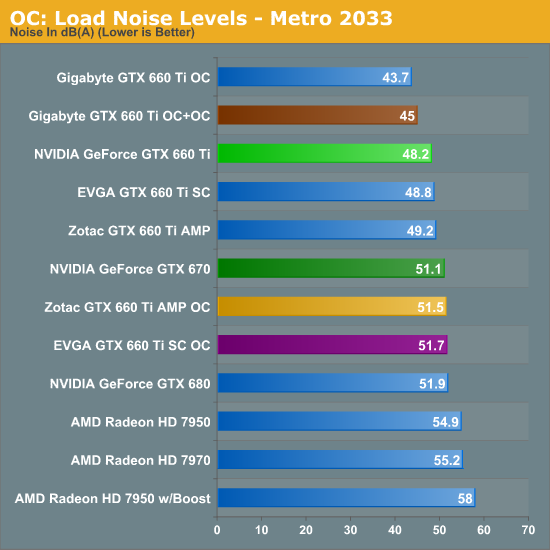
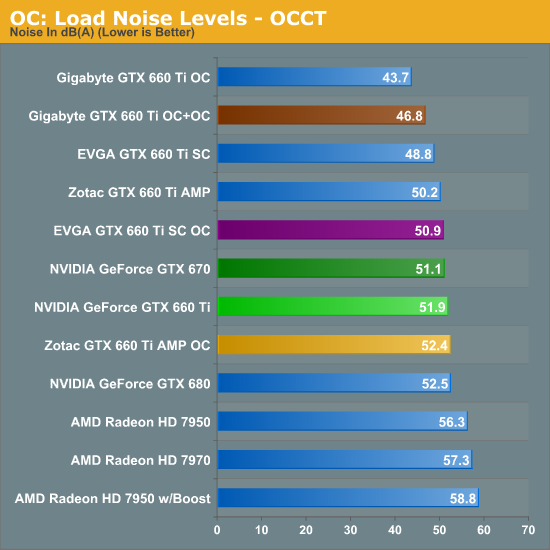
Last but not least, looking at noise levels we can see an increase similar to the temperature increases we just saw. For the Zotac and EVGA cards noise levels are roughly equal with the reference GTX 680, which will be important to remember for when we’re looking at performance. Meanwhile the Gigabyte card continues to shine in these tests thanks to its oversized cooler; even OCCT can only push it to 46.8dB.










313 Comments
View All Comments
CeriseCogburn - Thursday, August 23, 2012 - link
660Ti is hitting over 1300 core.amd loses in oc this time
Get used to changing your whistling in the dark tune
TheJian - Sunday, August 19, 2012 - link
http://www.guru3d.com/article/radeon-hd-7950-overc..."We do need to warn you, increasing GPU voltages remains dangerous."
From page 2. Also note he says you can't go over 1ghz or so without hitting raising volts (he hit 1020 default). Raise your hand if you like to spend $300 only to blow it up a few days or months later. Never mind the Heat, noise, watts this condition will FORCE you into. His card hit a full 10c and 6db noisier than defaults. He hit 1150/1250boost max. Only 50mhz more than the 660ti. Nice try. From page 11 7950 BOOST review at gurud3:
http://www.guru3d.com/article/radeon-hd-7950-with-...
"In AMD's briefing we notice that the R7950 BOOST cards will be available from August 16 and onwards, what an incredibly coincidental date that is. It's now one day later August 17, just one AIC partner has 'announced' this product and there is NIL availability. Well, at least you now have an idea of where the competition will be in terms of performance. But that's all we can say about that really."
Note you can BUY a 660TI for $299 or $309 that is clocked by default only 14mhz less than the zotac AMP in this review. If Ryan is to note what you want in the article, he should also note it will possibly light on fire, or drive you out the room due to heat or noise while doing it. AMD isn't willing to BACK your speeds. Heck the DEFAULT noise/heat alone would drive me out of the room, never mind the extra cost of running it at your amazing numbers...LOL. A quick look at the 7950B already tells the story above it's ref speeds/volts. RIDICULOUS NOISE/HEAT/COST.
From guru3d article above:
Measured power consumption default card=138 Watts
Measured power consumption OC at 1150 MHz (1.25 Volts)=217w!! Note the one in Ryan's review is clocked at 850mhz and already 6.5db's higher than 660TI AMP. I want a silent (or as close as poosible) PC that won't heat the room or every component in my PC.
http://benchmarkreviews.com/index.php?option=com_c...
1122mhz CORE on 660TI. The gpu boost hit 1200! That's 31% above stock (and I only googled one oc review), and I don't think this is as HOT as your 1150 would be, nor as noisy. Scratch that, I KNOW yours will be worse in BOTH cases. Just look at this review at anandtech with zotac at 1033mhz already. The zotac Amp is also 5c cooler already and you haven't got over 850mhz on the 7950 boost here. Try as you might, you can't make AMD better than they are here. Sorry. Even Anand's 7950 boost review 4 days ago says it's hard to argue for the heat/noise problem added to the already worse 7950 regular vs 660 ti. Not to mention both 7950's are more expensive than 660ti. It's all a loss, whether or not I like AMD. Heat/temp/watts are WORSE this time around on AMD. Raising to higher clocks/volts only makes it worse.
I already pointed out in another post Ryan should have posted 900mhz scores, but not to help AMD, rather that's what I'd buy if I was looking for a card from AMD for the going market cards on newegg. You just wouldn't purchase an 800mhz version (or even 850mhz), but AMD would have paid the price in the heat/watts/noise scores if Ryan did it. I would still rather have had it in there. Anandtech reviews seem to always reflect "suggested retail prices and speeds" rather than reality for buyers. That still doesn't help your case though.
It's not ridiculously easy to OC a 7950boost to 35-45% higher...Which loses a lot at 1920x1200, by huge margins, and warhead is useless as shown in my other posts, it's a loser in crysis2 now for boost vs. 660ti's of any flavor above ref.
http://www.guru3d.com/article/radeon-hd-7950-with-...
Crysis 2 ultra uber dx 11 patches everything on high. WASH for 7950 boost vs. REF 660ti! Why did Anandtech choose 2008 version?
Ref 660TI which nobody would buy given pricing of high clocked versions at $299/309 for 660 TI, default no fiddling necessary and no voiding warranty or early deaths of hardware. You seem to ignore what happens when you OC things past reasonable specs (already done by AMD with heat/noise/watts above zotac Amp here). I suspect AMD didn't want their chip to look even worse in reviews.
Argument over. I win... :)...So does your wallet if you put your fanboyism away for a bit. Note I provided a google search to my RADEON 5850 XFX purchased card complaints (regarding backorder) at amazon in another post here. I love AMD but, c'mon...They lost this round, get over it. You may have had an argument for a 7950 boost at $299 that was actually COOLER than the 7950 regular and less noisy. But with both being worse, & price being higher...It's over this round. Note the cool features of the 600 series cards in the above oc article. It's safe at 1122/1200! It's safe no matter the card, though they vary you can't hurt them (per card settings are different...Ultimate OC without damage). Nice feature.
I'd argue blow by blow over 2560x1600 (as you can prove NV victories depending on games) but I think it's pointless as I already proved in other posts, only 2% actually use that or above. Meaning 98% are using a res where the 660TI pretty much TRASHES the 7950 in all but a few games I could find (1920x1200 and below).
(hit post but didn't post...sorry if I'm about to double post this).
Galidou - Sunday, August 19, 2012 - link
It's fun to see that Nvidia as reached a very good power consumption and heat level compared to the generation before. How they mention it, but when AMD fanboys were mentioning it, coparing 6xxx against gtx5xx, they were just denied and being told it wasn't important.''Measured power consumption OC at 1150 MHz (1.25 Volts)=217w''
Wow it's amazing, 217 watts, almost as much as a gtx 580 stock.....
Comparing the 7950b noise and temperature with the very bad reference cooler against a very quiet aftermarket cooler on the 660 ti, very nice apples to apples comparison. The 7950b is for the average users, we all know the 7950 models that are overclocked and got VERY nice coolers already, thanks for the refresh.
TheJian - Monday, August 20, 2012 - link
This AMD fanboy bought a radeon 5850. Not sure what your point is?The ref design was in there too...Check the green bar card.
Galidou - Monday, August 20, 2012 - link
Well, the reference design works wonders on 660 ti because it has alot better power consumption and temperatues, the 7xxx reference coolers are just plain crap, good thing there's not much around, else the opinion of the 7xxx series would be uber bad.Overclockers tend to love the radeons and I'm an overclocker, not an AMD fanboy, I just can't support all the hate when there'S no reason for it.
CeriseCogburn - Thursday, August 23, 2012 - link
radeon 6000 series was losing the benches as it "saved power"580 was referred to as housefire and worse, nVidia was attacked for abandoning gamers w/compute
ROFL - abandoning the gamers
green earth became more important than gaming
losing frame rates was a-okay because you saved power and money
Compare that to now - nVidia is faster, quieter, smoother, and uses less power
amd loses frames, and sucks down the juice, and choppier
The 580 had a HUGE lead at the top of the charts....
So, that's the same how ?
It would be the same if amd hadn't completely failed on frame rates and had a giant lead stretching out in disbelief at the top of the charts - then one can say "the power doesn't matter" because you get something for it
It's really simple. So simple, simpletons should be able to understand. I don't think fanboys will though.
RussianSensation - Thursday, August 16, 2012 - link
Well in fairness AnandTech did test reference clocked 660Ti cards, which is a fair review. They also could have included factory pre-overclocked 660Ti cards and just commented on the price difference (i.e., up to $339). This was also mentioned in the review.But what I find the most amusing is that after how much talk was around the amazing overclocking capabilities of GTX460, NV users want to ignore that HD7950 can overclock to 1.1-1.15ghz and match a $500 GTX680. Can a GTX660Ti do that? At the end of the day an overclocked 7950 will beat an overclocked 660Ti with AA. Overclockers will go for the 7950 and people who want a quiet and efficient card will pick the 660Ti.
just4U - Thursday, August 16, 2012 - link
Does a 1.1-1.5GHZ 7950 actually match up well against a GTX680? While AMD and NVidia perform better on different games I'd still think the 680 would be somewhat ahead..CeriseCogburn - Sunday, August 19, 2012 - link
No the 7950 does not, it takes a 1200-1250 core 7970 to "match up".Even then, it can only match up in just "fps".
It still doesn't have: PhysX, adaptive v-sync, automatic OC, target frame rate, TXAA, good 3D, Surround center taskbar by default without having driver addons, STABILITY, smoothest gaming.
I could go on.
Hey here's a theory worthy of what we hear here against nVidia, but we'll make it against the real loser amd.
It appears amd has problems with smooth gameplay because they added a strange and unable to use extra G of ram on their card. Their mem controller has to try to manage access to more ram chips, more ram, and winds up stuttering and jittering in game, because even though the extra ram is there it can't make use of it, and winds up glitching trying to mange it.
There we go ! A great theory worthy of the reviewers kind he so often lofts solely toward nVida.
Galidou - Sunday, August 19, 2012 - link
Look at all the big words: ''PhysX, adaptive v-sync, automatic OC, target frame rate, TXAA, good 3D, Surround center''. Stability is my preffered, I owned so many video cards and had so little problems with them, Nvidia ATI or AMD but still Nvidia fanboys still have to make us feel that everytime you buy a video card from AMD, you gotta have to face the ''inevitable'' hangups, drivers problems, the hulk is gonna come at your home and destroy everything you OWN!!!! Beware if you buy an AMD video card, you might even catch.... ''CANCER''. oohhh cancer, beware....I had none of that and still has none of that and ALL my games played very good, memory is the problem now, not the lack of adaptive crapsync, physixx and such. You just made me remember why I do not listen to TV anymore, the adds always try to make you feel like everything you own should be changed for the new stuff, but then you change it and you feel almost nothing has been gained.
I call for ''planned obsolescence'' for the last message.